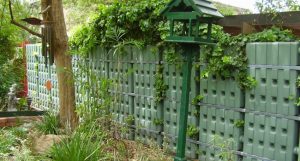
The Adelaide company behind the original plastic slimline rainwater tank in Australia is rebooting its business after a five-year hiatus to focus on the drought ravaged US market.
About 35,000 Freewater Super-slim Rainwater Tanks were manufactured in Australia from 2001 to 2014 with nearly 70 per cent sold in Australia and the rest exported as Oziflow around the world to countries including England, Spain, Canada and the US.
Less than 20cm wide, the 220-litre tanks are designed to fit snugly against walls or fences and can be linked together like Lego bricks to increase storage capacity.
The “flat-pack” tanks were sold through Kmart, Stratco, Mitre 10 and through Bunnings as Nylex Freewater, in Australia at a time when water restrictions and building requiring rainwater tanks to be installed in new homes were driving demand.
Unlike many other polyethylene tanks that are rotationally moulded, the Oziflow tanks are blow moulded in just four minutes, adopting a similar technique that is used to manufacture PET soft drink bottles.
However, no tanks have been produced since 2014 due to the closure of Oziflow’s Australian blow-mould manufacturer, increased competition and the maturation of the Australian rainwater tank.
Oziflow also lost control of its production tool when the manufacturing company was sold off and ultimately shut its doors.
Founder Aaron Richards said after almost five years grappling with ways to reboot the business, he was contacted in June about the whereabouts of the tool, which is still in good working order.
He said the production tool would be refurbished and sent from Australia to South Carolina next month, which will allow the blow-moulded tanks to be made on US soil from November.

The tanks will be sold through Walmart-owned Sam’s Club, where they are currently promoted online.
The componentry and mounting systems will still be made in South Australia. Oziflow is working with Adelaide company Detmold Group on packaging so the components can be shipped to the tank manufacturer Mergon Corporation in South Carolina.
South Australia is considered a global leader in rainwater harvesting and reuse.
It was this expertise that attracted a delegation of American local bureaucrats and university professors to Adelaide in 2012 looking for solutions developed in Australia during the Millennium Drought.
“I identified the US when we met that delegation about seven years ago when they had just started their journey into drought and that’s when I really opened up to the opportunities over there,” Richards said.
“We have an established reputation and we traded on that in moving the product into the US.
“It is really an untapped market.”
Richards said the ability to manufacture the product quickly and Mergon’s proximity to a major Walmart distribution centre helped keep the supply chain manageable.
“Because it’s rapidly made, it’s rapidly sold. At Kmart in Australia it became known as the flat-pack water tank and that model is being transposed into Sam’s Club,” he said.
“When you’ve got a manufacturing capacity of up to 5000 units per week across multiple shifts in a blow moulding facility that’s a lot of product you can ship.”
Mergon also has manufacturing facilities in Ireland and the Czech Republic potentially allowing for easy expansion into Europe and the United Kingdom.
However, Richards is focusing on North America for now and has a conservative minimum goal of 3000 tanks in the first year, ramping up to 300,000 tanks in year five.
“One of the lessons I’ve learned in the past is not trying to be everything to everyone,” he said.
“I’ve got big opportunities in the US where they are in drought and looking for solutions.
“They do water storage domestically but they don’t do it very well so we’ve marketed ourselves as the rain barrel experts.”
Richards said the tanks were rarely initially sold individually with users usually buying three to five tanks in the first instance.
“One of the things we were finding in the US that was emulating the experience in Australia was customers coming back year after year and buying two or three more tanks and adding them on,” he said.
“I’m a big believer in I win or I learn.
“I’ve made a lot of mistakes and I’ve learned a lot out of them to the point where I’m thinking about making some more mistakes.”
















